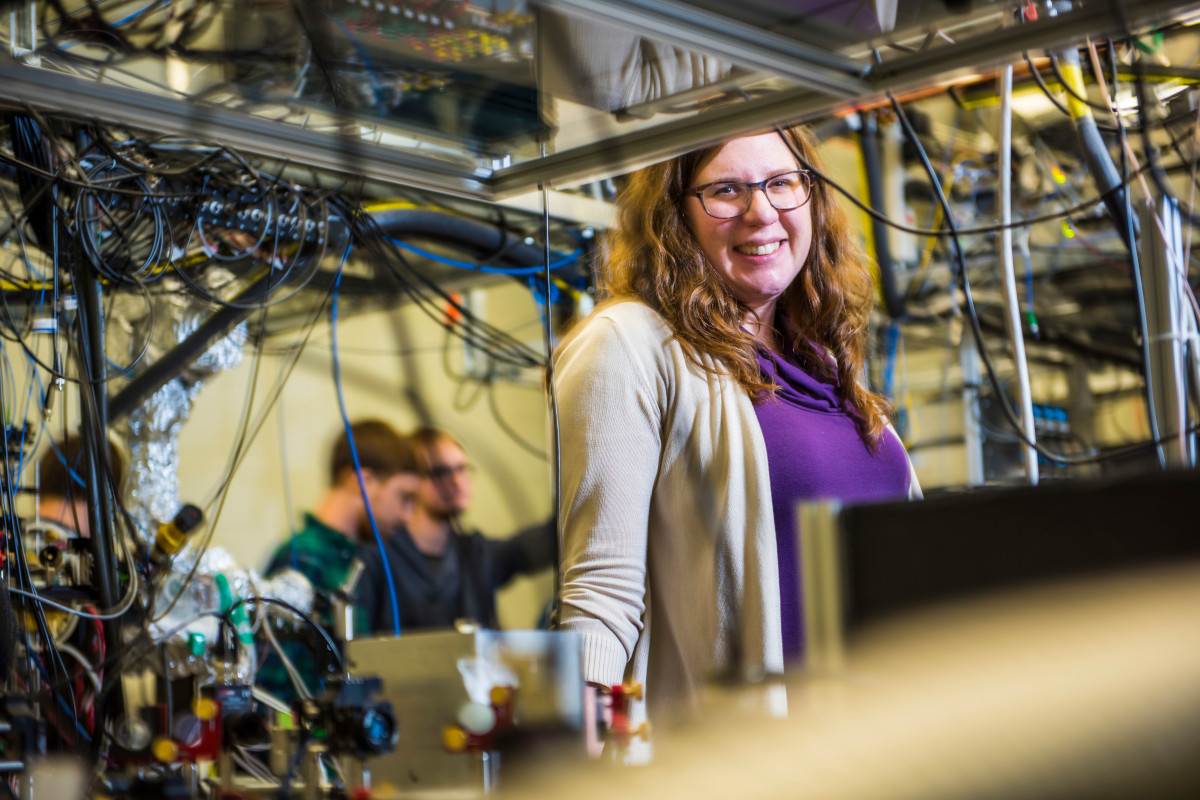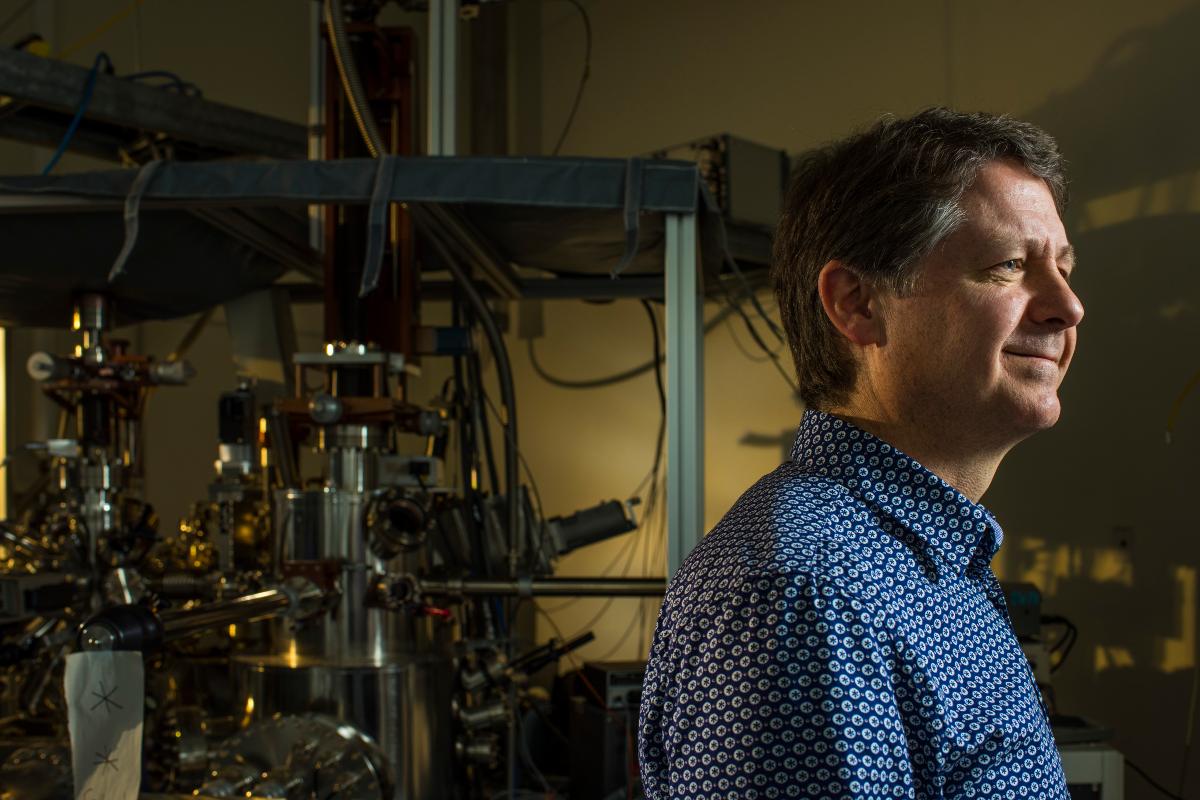Quantum Nanoscience and Technology
Quantum nanoscience and technology are becoming vital components in diversifying Alberta's economy. Scientists are making great strides in these areas to accelerate our province's quantum advantage.
On this page you'll find information about quantum nanoscience, including associated educational opportunities, what our scientists are working on in this area, and the effect their work has.
New $25M network set to expand horizons for fundamental quantum research in Alberta
A new donor-supported provincewide network will harness leading expertise across three universities to create a globally recognized research hub. Learn more.
What Is Quantum Science?
Quantum science focuses on the properties of matter on the atomic scale, where the wave-like nature of particles becomes apparent. Here, scientists study behaviours, including tunnelling, superposition, and entanglement to understand the nature of materials, how information can be processed on the quantum level, and how to harness these effects for new technologies.
Quantum Technology
Many current technologies rely on some degree of "quantumness" to operate, including solar cells, superconducting magnets for medical magnetic resonance imaging (MRI), lasers, CCD cameras, and light-emitting diodes (LEDs), among others.
The next generation of technologies based on quantum physics (and its offspring, quantum chemistry and quantum biology) will dominate the landscape, with:
- quantum computation solving intensely complex chemical and biological questions,
- quantum cryptography providing unhackable secure communication for e-commerce and ever-expanding cloud data storage over quantum networks,
- and quantum-enabled solar cells.
The Nanoscale
The research and work involving nanotechnology takes place on the nanoscale (somewhere between 1 and 100 nanometers).
To help understand just how small the nanoscale is:
- there are 1 million nanometers in 1 millimeter,
- and one standard sheet of printing paper is about 100,000 nanometers thick.
The fact that the nanoscale deals in quantities 1000 times smaller than the thickness of a sheet of paper highlights a natural difficulty in this microscopic area of science, but at such a small scale, there is also great potential for applications.
Latest Quantum Nanoscience News
Read about the latest quantum nanoscience and technology research coming out of UAlberta that is making headlines.
Who Is Working in Quantum & Nanoscience?
The following are UAlberta researchers who focus their efforts quantum science, nanoscience, nanotechnology, and more.
- Al Meldrum
Al Meldrum's areas of expertise include: condensed matter, nanotechnology, optical sensors, microcavities, quantum dots, fluorescence microscopy and spectroscopy, and photonic microfluidics.
- Alex Brown
Alex Brown's areas of expertise include: computational design of small-molecule biofluorophores, understanding of novel bonding and structure in inorganic materials, photochemistry and photophysics of fluorescent proteins, theoretical/computational studies of molecular photochemistry and laser control, optimal control theory for laser control, and molecular quantum dynamics (using MCTDH).
- Arthur Mar
Arthur Mar's areas of expertise include: synthesis, characterization, and applications of inorganic solid state materials; crystallography; condensed matter physics; and materials science.
- Eric Rivard
Eric Rivard's areas of expertise include: synthetic inorganic and polymer chemistry, solar energy, catalysis, chemical sensing, and quantum mechanical (DFT) methods.
- Frank Hegmann
Frank Hegmann's areas of expertise include: ultra-fast terahertz science and nanophysics.
- Frank Marsiglio
Frank Marsiglio's areas of expertise include: theory of high-temperature superconductivity, polaron physics, nanoscale superconductivity, strong electron correlations in solids; the electron-phonon Interaction in solids, and spin current-induced spin-flip interactions.
- Jack Tuszynski
Jack Tuszynski's areas of expertise include: collective dynamics of cellular proteins, rational drug design for cancer chemotherapy, and nonlinear models of pharmacokinetic processes.
- Jillian Buriak
Jillian Buriak's areas of expertise include: green chemistry, inorganic chemistry, materials and surfaces, nanotechnology, natural resources and energy, solar cells, nanopatterns, semiconductors, block copolymers, surface chemistry, nanostructures, nanoparticles, metal nanostructures, metal oxide nanostructures, self-assembly, renewable energy, and cleantech.
- John Davis
John Davis's areas of expertise include: optomechanics, nanomechanics, quatum optomechanics, superfluid 3He, nanofabrication, nanotechnology, quantum fluids, nanomechanical resonators, nanoscale superconductivity, quantum resonators, low temperature physics, condensed matter physics, superfluid helium, mesoscopic superconductors, and thin films of helium.
- Jon Veinot
Jon Veinot's areas of expertise include: green chemistry, inorganic chemistry, materials and surfaces, nanotechnology, quantum materials, nanomaterials, silicon, sol-gel, polymers, polymer brushes, surface chemistry, surface induced polymerization, and nanoengineered hybrids.
- Joseph Maciejko
Joseph Maciejko's areas of expertise include: theoretical condensed matter physics; emergent phenomena in quantum many-body systems; topological phases of matter including topological insulators, superconductors, and superfluids; topological semimetals; quantum Hall liquids and spin liquids; quantum transport in low-dimensional systems and semiconductor physics; fractionalization and strongly correlated systems; field theories of many-body systems; and connections between condensed matter physics and high-energy physics.
- Lindsay LeBlanc
Lindsay LeBlanc's areas of expertise include: quantum physics, quantum gases of ultracold atoms, laser cooling, optical trapping, magnetic field control, quantum simulation, and hybrid quantum systems and quantum technologies.
- Mark Freeman
Mark Freeman's areas of expertise include: condensed matter, nanotechnology, magnetism, mesoscopic magnets, magnetic resonance and spin dynamics, nanomechanical resonators, barkausen effect, Einstein-de Haas and barnett effects, cavity optomechanics, nanofabrication, magnetometry, susceptometry, and microscopy
- Mark McDermott
Mark McDermott's areas of expertise include: analytical chemistry, materials and surfaces, nanotechnology, nanoparticles, bioassay, surface modification, plasmonics, raman spectroscopy, surface plasmon resonance, nanocomposite, enhanced spectroscopy, cellulose nanocrystals, and aptamers.
- Ralf Schirrmacher
Ralf Schirrmacher's areas of expertise include: the development of new imaging agents for Positron Emission Tomography (PET) imaging in the field of oncology and neurology, development of novel radiolabeling strategies for peptide and protein labeling for cancer imaging, and nano particle PET platform development.
- Richard McCreery
Richard McCreery's areas of expertise include: analytical chemistry, nanotechnology, molecular electronics, surfaces and interfaces, optical spectroscopy, thin film devices, organic electronics, and charge transport in solid state.
- Rik Tykwinski
Rik Tykwinski's ares of expertise include: physical organic chemistry; new synthetic methods to carbon-rich molecules (e.g., cumulenes and polyynes, acenes, and polycyclic aromatic hydrocarbons); relationships between chemical structure and molecular reactivity/properties; synthesis of compounds for applications as wires in single-molecule devices, solar cells, TFTs, and singlet fission; and synthetic model compounds for the asphaltenes.
- Robert Wolkow
Robert Wolkow's areas of expertise include: condensed matter, nanotechnology, scanning probe microscopy, ultra high vacuum, nano-scale chemical physics, atomically precise fabrication, atom scale properties of surfaces, nano-device physics, quantum effect devices, semiconductor materials and devices, and surface spectroscopy.
- Wolfgang Jäger
Wolfgang Jäger's areas of expertise include: molecular interactions, development and use of state-of-the-art scientific instrumentation, computer programming for experiment control, spectral analyses to syntheses of isotopically labelled compounds, and rotational and ro-vibrational spectra of binary and ternary van der Waals complexes,
- Yunjie Xu
Yunjie Xu's areas of expertise include: using mid infrared laser spectroscopy, Fourier transform vibrational circular dichroism spectroscopy, and ab initio computational methods to study chirality.
Graduate Studies in Nanoscience

Quanta: Quantum Nanotechnology Training in Alberta
Quanta is a unique graduate studies opportunity that allows prospective students to focus on research related to the emerging industry of Quantum Age technology.
Students will:
- conduct research collaboratively with institutional and industrial partners,
- receive hands-on technical training in nanotechnology,
- develop project management skills,
- cultivate an entrepreneurial spirit,
- receive travel opportunities and career support, and more.
Applications and Opportunities
A century of research has laid the foundations that give us a deep understanding of matter on the atomic scale, while at the same time, fabrication technologies have made it possible to manipulate matter and build devices on the nanometer scales where these quantum effects begin to manifest.
Researchers in the Faculty of Science study quantum nanoscience and technology from many angles:
- using scanning tunnelling microscopy to uncover and control the properties of matter, atom-by-atom;
- developing ultra-precise, quantum-limited sensors;
- using laser-cooled atoms to store and manipulate optical quantum information;
- unearthing how quantum particles coalesce into many-particle states; and more.
The possibilities for applying nanotechnology in the real world are virtually infinite, and although a common application is to use nanotechnology to improve the capabilities of electronics, there is also potential to use nanoscience outside the realm. For instance, UAlberta chemists have experimented bonding nano-scale quantum dots with enzymes and cells within the body to increase the efficiency for medical imaging and potentially for treatment of diseases like cancer.

Transforming information from microwaves to optical light
New tool has the potential to translate data from quantum computers to quantum communications channels.

Tiny technology, big recognition: Physicist honoured with international award for nanotechnology
University of Alberta physicist honoured with AVS Nanotechnology Recognition Award.

